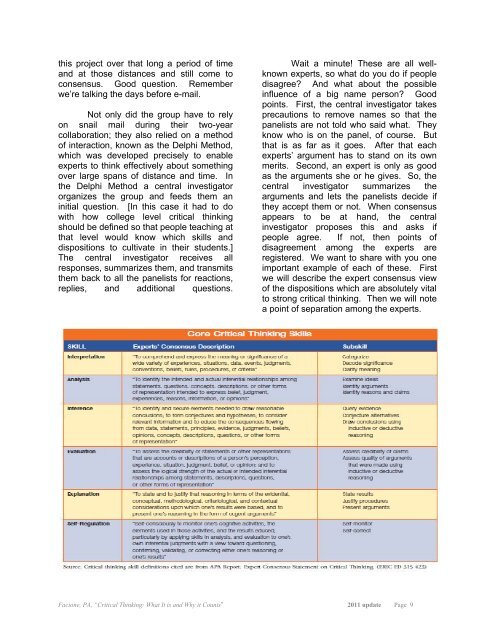Critical Thinking for Transformative Justice
Critical Thinking for Transformative Justice
Critical Thinking for Transformative Justice
You also want an ePaper? Increase the reach of your titles
YUMPU automatically turns print PDFs into web optimized ePapers that Google loves.
this project over that long a period of time<br />
and at those distances and still come to<br />
consensus. Good question. Remember<br />
we’re talking the days be<strong>for</strong>e e-mail.<br />
Not only did the group have to rely<br />
on snail mail during their two-year<br />
collaboration; they also relied on a method<br />
of interaction, known as the Delphi Method,<br />
which was developed precisely to enable<br />
experts to think effectively about something<br />
over large spans of distance and time. In<br />
the Delphi Method a central investigator<br />
organizes the group and feeds them an<br />
initial question. [In this case it had to do<br />
with how college level critical thinking<br />
should be defined so that people teaching at<br />
that level would know which skills and<br />
dispositions to cultivate in their students.]<br />
The central investigator receives all<br />
responses, summarizes them, and transmits<br />
them back to all the panelists <strong>for</strong> reactions,<br />
replies, and additional questions.<br />
Wait a minute! These are all wellknown<br />
experts, so what do you do if people<br />
disagree? And what about the possible<br />
influence of a big name person? Good<br />
points. First, the central investigator takes<br />
precautions to remove names so that the<br />
panelists are not told who said what. They<br />
know who is on the panel, of course. But<br />
that is as far as it goes. After that each<br />
experts’ argument has to stand on its own<br />
merits. Second, an expert is only as good<br />
as the arguments she or he gives. So, the<br />
central investigator summarizes the<br />
arguments and lets the panelists decide if<br />
they accept them or not. When consensus<br />
appears to be at hand, the central<br />
investigator proposes this and asks if<br />
people agree. If not, then points of<br />
disagreement among the experts are<br />
registered. We want to share with you one<br />
important example of each of these. First<br />
we will describe the expert consensus view<br />
of the dispositions which are absolutely vital<br />
to strong critical thinking. Then we will note<br />
a point of separation among the experts.<br />
Facione, PA, “<strong>Critical</strong> <strong>Thinking</strong>: What It is and Why it Counts” 2011 update Page 9

















